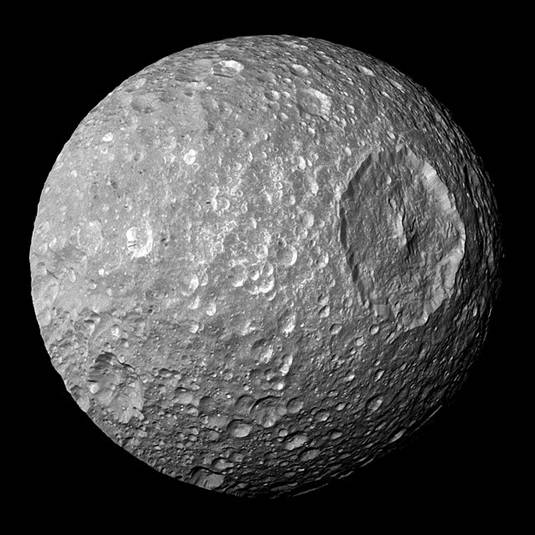This article is more than 1 year old
That's no – actually it is: DEATH STAR MOON 'could be full of life-friendly water'
Wobbles as it sloshes along, theorise astro boffins
Mimas has long been thought to be one of the less noteworthy moons of its vast ringed primary, Saturn – apart from its frankly worrying resemblance to the Death Star, that is. But now, a new study indicates that the humdrum space boulder could have, er, hidden depths.

Actually, that is a moon. Not a space station
A team of boffins have been studying the moon using the Cassini-Huygens spacecraft, which has been orbiting Saturn for the last ten years, and discovered Mimas' orbit wobbles much more than theoretical models allow.
"After carefully examining Mimas, we found it librates – that is, it subtly wobbles – around the moon's polar axis," said Radwan Tajeddine, Cornell research associate in astronomy and lead author of the paper published in Science.
"We're very excited about this measurement because it may indicate much about the satellite's insides. Nature is essentially allowing us to do the same thing that a child does when she shakes a wrapped gift in hopes of figuring out what's hidden inside."
The team used data from Cassini to build a 3D model of the moon's orbit and found it wobbles twice as much as it ought. Such wobbles can be caused by the gravity of passing of planetary masses, but Mimas' motion points to two other possibilities.
Firstly, it's possible that the rocky surface of the moon is hiding an ocean deep within the planet. At just 400 kilometers in diameter Mimas won’t have enough mass to have a hot core but tidal kneading caused by the close proximity of Saturn could provide enough heat for some of the moon's innards to be liquids. Based on the 3D modelling the ocean would have to be around 24 to 31 kilometers beneath the surface of the moon's crust to account for the wobble.
The second possibility is that Mimas' birth left it somewhat abnormal. Mimas is the smallest body in the solar system to be rounded due to self-gravitation – having enough mass to form into a ball without being torn apart.
The team postulates that the core of Mimas has been stretched out as it formed around Saturn and is slightly elongated. This would make the moon's orbit more unstable.
Ultimately we're not going to know until mankind and/or our machinery get to the surface and find out but the team will be making more Mimonian measurements to refine their theory for as long as Cassini still functions. ®
